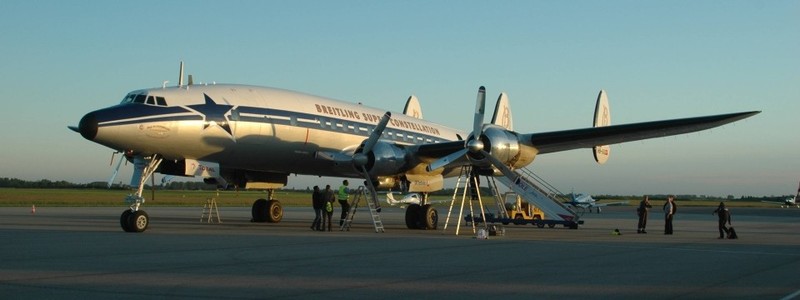
Am verschlafenen Flugplatz Dole im französischen Jura drehen normalerweise kleine Cessna oder Piper ihre Platzrunden. Für die Anrainer ist das ein gewohnter Anblick. Dass an den ersten Maitagen aber ständig ein Oldtimer von der Größe einer Boeing startet und landet, ist verblüffend. Es gibt einen Grund für dieses außergewöhnliche Prozedere. Eine Lockheed L-1049 Super Constellation aus der Schweiz absolviert hier mit ihren Crews die ersten Trainingsflüge vor Beginn der Flugsaison. Dass die Anwohner von Dole so ein ziemlich einzigartiges Spektakel erleben, wird den meisten gar nicht bewusst sein. Denn von der viermotorigen Super Constellation gibt es auf der Welt nur noch zwei fliegende Exemplare. Wer die andere Maschine erleben will, muss nach Australien reisen.
Auch der Kreis ihrer Piloten ist exklusiv. Derzeit dürfen vier schweizerische Flugkapitäne und ein Kopilot die aus Basel stammende Connie, so nennen alle die Super Constellation, fliegen. Zwei weitere Piloten der Deutschen Lufthansa absolvieren ebenfalls in Dole auf dem Klassiker ihre Checkflüge, da die Lufthansa Berlin Stiftung eine eigene Super Constellation restauriert. Zudem sind drei eidgenössische Bordmechaniker auf der Maschine zertifiziert, die ebenfalls auf diesen Flügen trainieren und von denen immer einer mit im Cockpit sitzt.
5000 Stunden Flugerfahrung sind Voraussetzung
Um die 1955 gebaute Connie steuern zu dürfen, ist zwar fliegerische Routine Grundvoraussetzung. Ein Kandidat fürs Cockpit muss aber auch Erfahrung mit Kolbenmotor-Flugzeugen haben, um mit den sensiblen Sternmotoren richtig umgehen zu können. In dieser Saison kommt ein neuer Pilot an Bord. Hans Breitenmoser fliegt im Alltag als Flugkapitän einen Airbus A340, gespickt mit modernen Autopiloten, Kollisionswarngeräten und Computern. Allerdings ist der Schweizer ebenso seit vielen Jahren als Pilot mit den Oldtimern Douglas DC-3 und Junkers Ju 52 vertraut. Das hilft bei der Umstellung auf die Connie. Die Super Constellation Flyers Association (SCFA) als Halter der Maschine verlangt zwar keine ausdrückliche Mindestflugstundenzahl von ihren Piloten. Allerdings besteht die Versicherung darauf, dass angehende Connie-Piloten mindestens 5000 Stunden Flugerfahrung aufweisen können, bevor sie die Maschine fliegen dürfen.
Breitenmoser absolviert beim Training in Dole unter Aufsicht von Super-Connie-Kapitän und Fluglehrer Francisco Agullo zahlreiche Starts und Landungen als Einweisung auf die Maschine. Zuvor hat er eine umfangreiche theoretische Unterrichtung über die hydraulischen, elektrischen und mechanischen Systeme erhalten sowie einen Überblick über die Notverfahren. Dass der Neue sich zuvor im Selbststudium mit dem Pilotenhandbuch für die Maschine beschäftigt hat, wird ohnehin vorausgesetzt. Außerdem ist im Connie-Cockpit neben den beiden Piloten immer auch ein Bordmechaniker für das Bedienen und Überwachen der Triebwerke dabei. Deshalb wird die Kommunikation zwischen dem neuem Crewmitglied und dem Flight Engineer geübt.
ENGLISCH :
At the sleepy Dole airport in the French Jura, small Cessna or Piper usually make their rounds. For the residents this is a familiar sight. However, the fact that on the first days of the year, an old-timer of the size of a Boeing starts and lands is astonishing. There is a reason for this extraordinary procedure. A Lockheed L-1049 Super Constellation from Switzerland completes the first training flights with their crews before the start of the flight season. That the residents of Dole will experience such a rather unique spectacle, most will not even be aware of. Because of the four-engine Super Constellation there are only two flying specimens in the world. If you want to experience the other machine, you must travel to Australia.
The circle of their pilots is also exclusive. At present, four Swiss flight capitals and one copilot are allowed to fly the Connie from Basel, so all the Super Constellation calls. Two other pilots of the German Lufthansa also do their checkflights in Dole on the classic, as the Lufthansa Berlin Foundation has restored its own Super Constellation. In addition, three Swiss aircraft mechanics are also certified on the aircraft, who also train on these flights, one of which is always in the cockpit.
5000 hours of flying experience are a prerequisite
In order to be able to control the Connie built in 1955, flying routine is essential. A candidate for the cockpit, however, must also have experience with piston engine aircraft to deal with the sensitive star motors properly. This season, a new pilot comes on board. In everyday life, Hans Breitenmoser flies an Airbus A340, spiked with modern autopilots, collision warning devices and computers. However, the Swiss has also been familiar with the oldtimers Douglas DC-3 and Junkers Ju 52 for many years as a pilot. This helps with the conversion to the Connie. The Super Constellation Flyers Association (SCFA) as the operator of the aircraft does not require an explicit minimum number of hours of flight from its pilots. However, the insurer insists that the upcoming Connie pilots can have at least 5000 hours of flying experience before flying the aircraft.
Breitenmoser completed numerous starts and landings as an introduction to the machine under the supervision of Super Connie captain and flight instructor Francisco Agullo during the training in Dole. Prior to this, he received extensive theoretical information on the hydraulic, electrical and mechanical systems as well as an overview of the emergency procedures. The fact that the new one has previously dealt with the pilot manual for the machine in self-study is already assumed. In the Connie cockpit, besides the two pilots, there is also an on-board mechanic for the operation and monitoring of the engines. Therefore the communication between the new crew member and the flight engineer is practiced !

